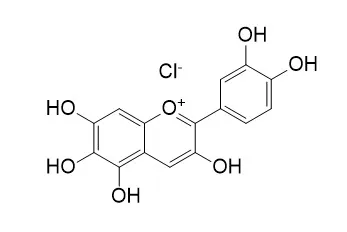| In vitro: |
| Naunyn Schmiedebergs Archives of Pharmacology, 2004, 370(4):290-298. | | Vasorelaxing effects of flavonoids: investigation on the possible involvement of potassium channels.[Pubmed: 15378228] | A flavonoid-rich diet has been associated with a lower incidence of cardiovascular diseases, probably because of the antioxidant and vasoactive properties of flavonoids. Indeed, many flavonoids show vasorelaxing properties, due to different and often not yet completely clarified mechanisms of action. Among them, the activation of vascular potassium channels has been indicated as a possible pathway, accounting, at least in part, for the vasodilatory action of some flavonoid derivatives, such as apigenin and dioclein.
METHODS AND RESULTS:
Therefore, this work aims at evaluating, on in vitro isolated rat aortic rings, the endothelium-independent vasorelaxing effects of a number of flavonoid derivatives, to identify a possible activation of calcium-activated and/or ATP-sensitive potassium channels and to indicate some possible structure-activity relationships. Among the several flavonoids submitted to the pharmacological assay, only baicalein and quercetagetin were almost completely ineffective, while quercetin, hesperidin, quercitrin and rhoifolin exhibited only a partial vasorelaxing effect. On the contrary, acacetin, apigenin, chrysin, hesperetin, luteolin, pinocembrin, 4'-hydroxyflavanone, 5-hydroxyflavone, 5-methoxyflavone, 6-hydroxyflavanone and 7-hydroxyflavone, belonging to the chemical classes of flavones and flavanones, showed full vasorelaxing effects. The vasodilatory activity of hesperetin, luteolin, 5-hydroxyflavone and 7-hydroxyflavone were antagonised by tetraethylammonium chloride, indicating the possible involvement of calcium-activated potassium channels. Moreover, iberiotoxin clearly antagonised the effects of 5-hydroxyflavone, indicating the probable importance of a structural requirement (the hydroxy group in position 5) for a possible interaction with large-conductance, calcium-activated potassium channels.
CONCLUSIONS:
Finally, glibenclamide inhibited the vasorelaxing action of luteolin and 5-hydroxyflavone, suggesting that ATP-sensitive potassium channels may also be involved in their mechanism of action. |
|






 Cell. 2018 Jan 11;172(1-2):249-261.e12. doi: 10.1016/j.cell.2017.12.019.IF=36.216(2019)
Cell. 2018 Jan 11;172(1-2):249-261.e12. doi: 10.1016/j.cell.2017.12.019.IF=36.216(2019) Cell Metab. 2020 Mar 3;31(3):534-548.e5. doi: 10.1016/j.cmet.2020.01.002.IF=22.415(2019)
Cell Metab. 2020 Mar 3;31(3):534-548.e5. doi: 10.1016/j.cmet.2020.01.002.IF=22.415(2019) Mol Cell. 2017 Nov 16;68(4):673-685.e6. doi: 10.1016/j.molcel.2017.10.022.IF=14.548(2019)
Mol Cell. 2017 Nov 16;68(4):673-685.e6. doi: 10.1016/j.molcel.2017.10.022.IF=14.548(2019)